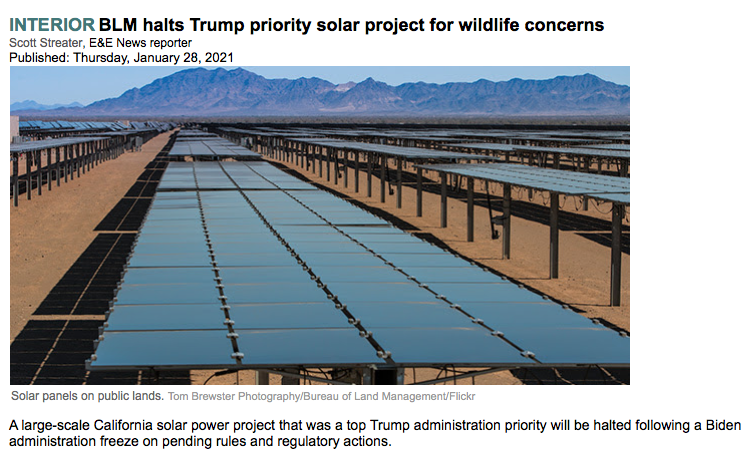Crimson Solar Project Back On
February 2, 2021 - Blythe CA. - The Bureau of Land Management suddenly reversed the "pause" of the review of the Crimson Solar Project, with a notice in the Federal Register under the Environmental Protection agency:
EIS No. 20210018, Final, BLM, CA,
Crimson Solar Project Final Environmental Impact Statement and Proposed Land Use Amendment to the California Desert Conservation Area Plan,
Review Period Ends: 03/15/2021,
Contact: Miriam Liberatore 951-697-5200.
https://public-inspection.federalregister.gov/2021-02888.pdf
See the story in the Desert Sun with our firnd Alfredo Figueroa interviewed:
Crimson Solar Project Withdrawn by Bureau of Land Management
January 29, 2021 - California Desert - Last week, the Bureau of Land Management (BLM) quietly approved the 2,500-acre Crimson Solar Project in eastern Riverside County CA. But an order was issued the same day by the new Interior Department suspending review of several projects on public lands. BLM announced it is withdrawing their current review of the Crimson Solar Project.
From a story in E&E News:
Kevin Emmerich, the co-founder of Nevada-based Basin and Range Watch, said he is pleased the Biden administration has halted the Crimson Solar Project.
"Basin and Range Watch would like to see the Interior Department cancel this project permanently," Emmerich said in an email.
He added: "The project will adversely impact archeology sites, ancient desert pavements, migratory bird habitat and sand transport corridors for Mojave fringe-toed lizards. The entire area is becoming a ground zero for solar energy development, but contains irreplaceable resources on valuable public lands. Solar energy can and should be used more in the built environment. Public lands are not renewable resources."
The order reads in part:
Sec. 1. Purpose. This Order is made for the purpose of implementing a targeted and time limited elevation ofrelevant decisions at the Department ofthe Interior (Department) for the purposes ofreviewing the questions offact. law. and policy they raise.
The temporary suspension order can be read here:
The order temporarily suspending Crimson Solar Project is here:
The October 31, 2019 BLM press release approving the Crimson Solar Project can be viewed here:
Crimson Solar Project Public Meetings
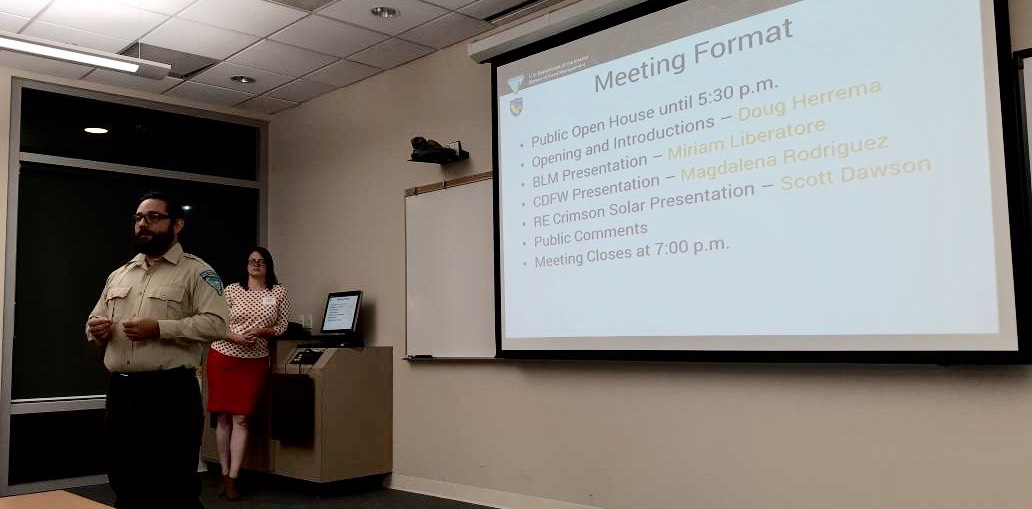
December 4, 2019 - We attended the December 2 public meeting in Palm Desert CA, and not a lot of people showed up despite the fact that this beautiful desert hold microphyll woodland and is near the Pacific Flyway route along the Colorado Desert. This proposed 2,500-acre photovoltaic project would lie on lands west of Blythe CA managed by the Bureau of Land Management (BLM). Hundreds of archaeology sites would be destroyed, as well as groves of desert ironwood and ocotillo. Mojave frige-toed lizards live here. The project would be built right next to the Mule Mountains Area of Critical Environmental Concern and be a visual disaster. Comments are due January 30, 2020. https://eplanning.blm.gov/epl-front-office/eplanning/planAndProjectSite.do?methodName=dispatchToPatternPage¤tPageId=131928
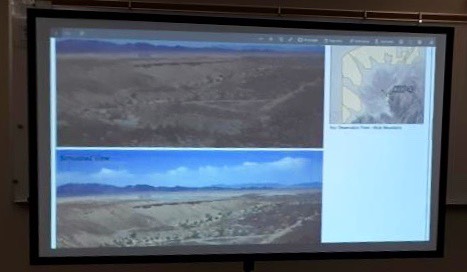
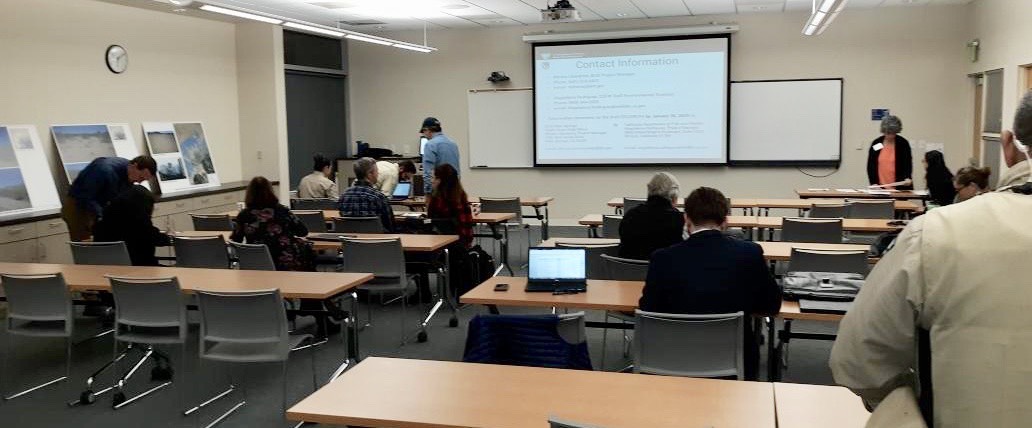
^Microphyll woodlands of desert ironwood around the base of the Mule Mountains. The reflective surface of the photovoltaic panels would create a lake-effect that could cause bird mortality.
Draft Environmental Impact Statement Out
November 1, 2019 - Blythe CA - In eastern Riverside County the beautiful California Desert has another proposal to carve up delicate ecosystems and do harm to rare wildlife species. This utility-scale solar project would be 2,500 acres on land managed by the Bureau of Land Management next to their pending 3,800-acre Desert Quartzite Solar Project making about 6,300 acres of good quality California Desert habitat the latest sacrifice. Cultural sites, Mule Mountains Area of Critical Environmental Concern, Bradshaw Trail, desert pavements, biological soil crust, burrowing owls, Mojave fringe-toed lizards, tortoise, will all be impacted.
This is in the East Riverside Solar Zone and Desert Renewable Energy Conservation Plan (DRECP) Development Focus Area. The pending November dicing of the DRECP will now most likely help these developers in the protected areas.
See the information here:
https://www.blm.gov/press-release/blm-seeks-public-comment-proposed-crimson-solar-project?fbclid=IwAR3M9YuQNCHy0lHuYNzC6xNCq8mlbSrh3CWHgk4aJxg8NxQGaJRKRBYk40Y
Map: https://eplanning.blm.gov/epl-front-office/projects/nepa/88925/142202/174606/Crimson_Project_Location_508.pdf
Basin and Range Watch is working with the think tank Solar Done Right to develop an advanced Distributed Energy Resource plan to bring positive solutions to fighting climate change with local microgrids and local solar power and storage. Stay tuned. These remote desert utility-scale power plants attached to long high-voltage transmission lines are a 20th Century form of energy, and we beleive the 21st Century needs to move forward. The bonus for California would be less wildfire-sparking transmission lines stretching hundreds of miles across wildlands.
More Public Meetings Discovered

^March 2018 map of the proposed project footprint wrapping around Mule Mountain.
April 5, 2018 - We just found out after a phone call with the Bureau of Land Management that two new public meetings are scheduled for the Crimson Solar Project. These were not on any BLM website about the project that we could find. It's difficult to have public input when there is no notofication of meetings.
Wednesday, April 11, 5:00 pm to 8:00 pm
UCR Palm Desert
75080 Frank Sinatra Drive
Palm Desert, CA 92211
Thursday, April 12, 12:00 noon to 3:00 pm
City of Blythe City Hall, Multipurpose Room
235 North Broadway
Blythe, CA 92225
Public Meeting Scheduled for Crimson Solar Project
March 26, 2018 - The Bureau of Land Management, Palm Springs-South Coast Field Office, has scheduled a public scoping meeting for the proposed Crimson Solar Project in eastern Riverside County on April 3 from 5:00 to 8:00 p.m. at the BLM Palm Springs South Coast Field Office, 1201 Bird Center Dr, Palm Springs, CA 92262. https://www.blm.gov/press-release/blm-schedules-public-scoping-meeting-crimson-solar-project
Crimson Solar with Battery Storage Proposal Back
March 9, 2018 - Blythe CA - The Bureau of Land Management is seeking public comment on the proposed Crimson Solar Project, located near Blythe in eastern Riverside. We have been following this project for years, and it went quiet fir a few years until today. That the project is seeking battery storage shows just how important this part of renewable energy will be in the future, as the overgeneration problem looms larger and larger with grid destabilization.
Sonoran West Solar Holding LLC., has requested a rights-of-way authorization to construct, operate, maintain, and decommission an up to 350-megawatt photovoltaic facility along with necessary ancillary facilities, including up to eight project substations, access roads, operations and maintenance buildings, and lay-down areas. The project site consists of approximately 2,700 acres of BLM-managed land.
“The Crimson Solar Project supports the economy and is an example of the Administration’s America First Energy Plan,” said Doug Herrema, BLM Palm Springs-South Coast Field Manager.
Our concerns include desert tortoise, Mojave fringe-toed lizard, kit fox, microphyll woodland, Colorado Desert Natural Communities with ocotillos, as well as cultural values.
The Notice of Intent scheduled to publish in the Federal Register on March 9, initiates a 30-day public scoping period that ends on April 9. The public is encouraged to comment on issues, concerns, potential impacts, alternatives and mitigation measures that should be considered in the analysis of the proposed action.
The scoping comments received will be considered during preparation of the draft environmental documents; comments will be available for public review in summer 2018. The environmental review will analyze the site-specific impacts on various resources.
See: https://www.blm.gov/press-release/blm-seeks-public-comment-desert-solar-project
New Storage Technology Proposed for Photovoltaic Project

March 27, 2016 - Blythe area CA - Sonoran West Holdings, LLC, a subsidiary of Recurrent Energy LLC, proposes to construct and operate the RE Crimson Solar Project, a utility‐scale solar photovoltaic (PV) and
energy storage project that would be located on federal lands managed by the Bureau of Land
Management (BLM) within the California Desert Conservation Area (CDCA) planning area. This project will be directly next to the Desert Quartzite Solar Farm, also south of I-10.
See the draft 2016 Plan of Development.
The project would connect with Southern California Edison (SCE) at the 220 kilovolt (kV) Colorado River Substation. The project would be located on up to 4,000 acres of public lands. It would generate up to 450 megawatts (MW) of renewable energy using PV technology and would include up to 450 MW of integrated energy storage capacity.
The Project site was formerly proposed for development as the Sonoran West Solar Energy Generating
Station proposed by BrightSource Energy. The proposal is located in unincorporated eastern Riverside County, approximately 13 miles west of Blythe, just north of Mule Mountain and south of I‐10. The Project site is situated at the east edge of the Chuckwalla Hydrologic Area and supports a broad alluvial fan that includes many braided washes and channels that converge into a primary channel flowing into an intra‐state playa lake northwest of the Project site. It is within a Desert Renewable Energy Conservation Plan (DRECP) Development
Focus Area. Also, the project is within a Solar Energy Zone defined during the Solar Programmatic Environmental Statement review. It is also placed in one of several sand transport systems.
The site is located at the northern foot of the Mule Mountain Area of Critical Environmental Concern, which is an important cultural resource for local Native American Tribes.
Desert Removal
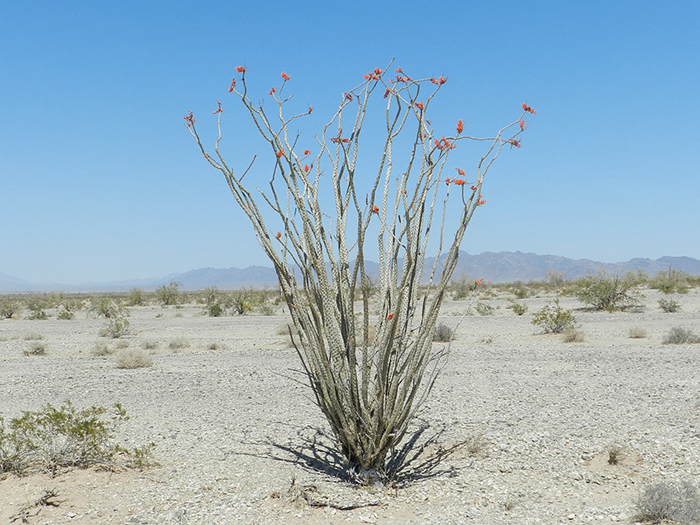
^Ocotillo blooming in 2012, around the site of the Crimson Solar Project, with the Mule Mountains in the distance. This region would have to be mowed and partly graded to accommodate a solar field.
During the construction phase, it is anticipated that up to 1,000 acre‐feet would be used per year for
dust suppression (including truck wheel washing) and other purposes. Across a majority of the site, a "low‐impact" mow and roll technique would be used to remove surface desert vegetation and keep root balls in place. In some areas, grubbing and grading would be required to level particularly rough areas of the site and to prepare soils for concrete foundations for substation equipment and inverters. Access road beds would also be grubbed, graded, and compacted. The fenceline would be grubbed and graded to create a level surface for proper fence installation. A Stormwater Pollution Prevention Plan would be prepared. Herbicides would then be used to suppress weeds (but also native wildflowers)
Photovoltaic Solar Field
Types of panels that may be installed include thin‐film panels (including cadmium telluride and copper indium gallium diselenide technologies), crystalline silicon panels, or any other commercially available PV technology.
Up to eight substations would be graded and compacted as well..
Storage System
This is the first photovoltaic solar project we have seen that seeks to integrate storage into its design. Usually concentrated solar thermal projects are being pushed to adapt storage technologies to their solar fields, but with the increased penetration of renewable energy, the California Public Utilities Commission has prioritized storage, and so PV developers are beginning to experiment with these designs.
From the Plan of Development (draft): "Storage systems can assist grid operators in more effectively integrating intermittent renewable resources into the statewide grid and can assist utilities in their efforts to meet energy storage goals mandated by the CPUC. The Project could include, at the Applicants’ option, a battery or flywheel storage system capable of storing up to 450 MW of electricity. If provided, the storage system would consist of battery or flywheel banks housed in electrical enclosures and buried electrical conduit. The battery system would either be concentrated near the Project substations or dispersed throughout the
Solar Facility site. Up to 3,000 electrical enclosures measuring 40 feet by 8 feet by 8.5 feet high would be
installed on concrete foundations designed for secondary containment, representing up to 12 acres of
impervious surface area. The Project could use any commercially available battery technology, including
but not limited to lithium ion, lead acid, sodium sulfur and sodium or nickel hydride. Battery systems are
operationally silent, and flywheel systems have a noise rating of 45 dBA."
Rich Desert Ecosystems
The site is a diverse Colorado Desert area with a high diversity of species, for which new surveys will have to be carried out: desert tortoise, Mojave fringe-toed lizard, burrowing owl, desert kit fox, golden eagle, elf owl, and gila woodpecker. Ocotillos and microphyll woodland consisting of desert ironwood grow in the area.

^Mule Mountains ACEC from the east side.
Groundwater Use and Air Quality
Other projects in the region have had severe violations of air quality in the eastern Chuckwalla Valley, with winds whipping up dust storms on graded projects sites, as at Genesis Solar Energy Project to the north of the I-10 highway.

^We photographed this dust storm on the construction sire of the Genesis Solar Energy Project in 2012, where a dust suppression plan was not working. The photo is from the approximate site of the proposed Crimson Solar Project looking northward across the I-10.
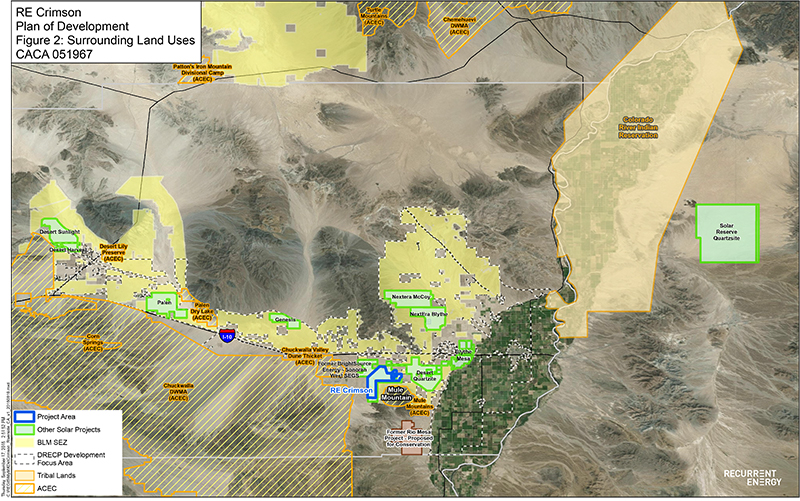
^Regional map of the Blythe area showing the cumulative impacts to this desert of the multiple large-scale solar projects.
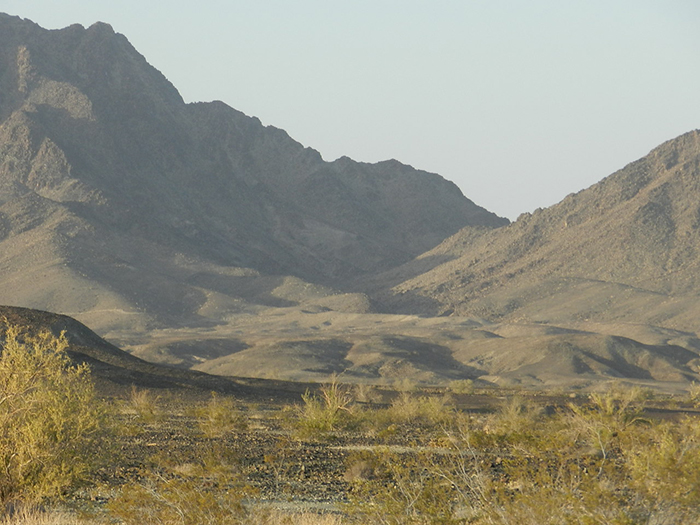
^Mule Mountains along the Bradshaw Trail along the south edge of the ACEC.
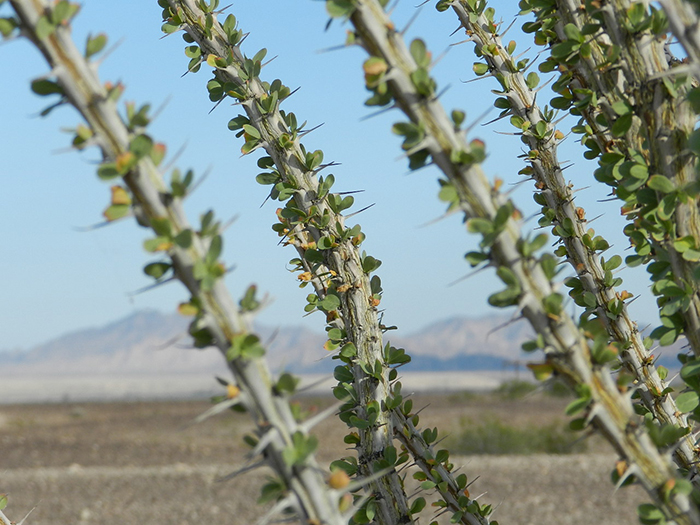
^Ocotillo leafing out near the Crimson Solar Project proposed site.
